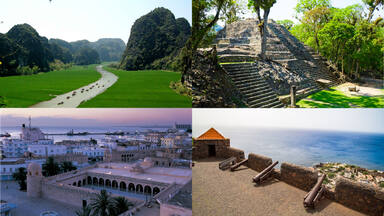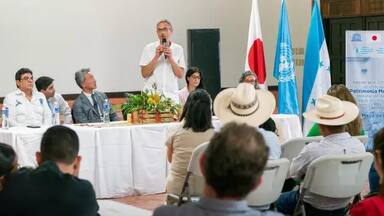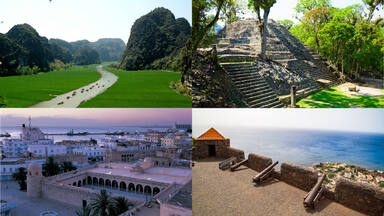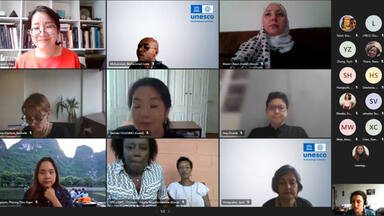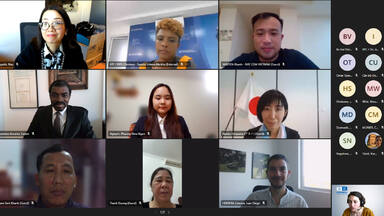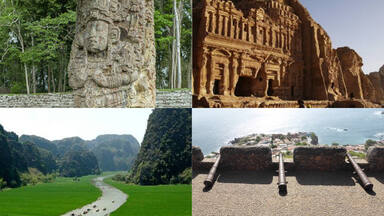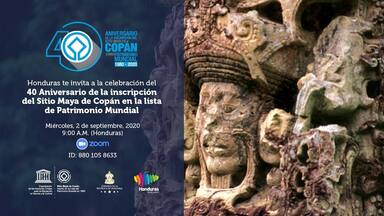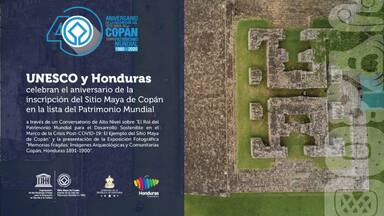Maya Site of Copan
Maya Site of Copan
Discovered in 1570 by Diego García de Palacio, the ruins of Copán, one of the most important sites of the Mayan civilization, were not excavated until the 19th century. The ruined citadel and imposing public squares reveal the three main stages of development before the city was abandoned in the early 10th century.
Description is available under license CC-BY-SA IGO 3.0
Site maya de Copán
Le site fut découvert en 1570 par Diego García de Palacio, mais des fouilles n'y ont été entreprises qu'à partir du XIXe siècle. C'est l'un des sites majeurs de la civilisation maya. Les ruines de son acropole et de ses places monumentales témoignent des trois grandes étapes de son développement, avant son abandon au début du Xe siècle.
Description is available under license CC-BY-SA IGO 3.0
موقع كوبان العائد لحضارة المايا
اكتُشف هذا الموقع دييغو غارسيا دي بالاسيو عام 1570، إلا أنّ الحفريات لم تبدأ إلا في القرن التاسع عشر. ويشكّل أحد أهمّ مواقع حضارة المايا. وتدلّ آثار قلعته والنصب التذكارية فيه على ثلاث حقبات زمنية لتطوره قبل هجره في مطلع القرن العاشر.
source: UNESCO/CPE
Description is available under license CC-BY-SA IGO 3.0
科潘玛雅古迹遗址
科潘遗址于1570年被迭戈·加西亚·德帕拉西奥(Diego García de Palacio)玛雅文明最重要的地点之一 ,一直到19世纪才被挖掘出来。废弃的城堡和壮丽的公共大广场体现了它10世纪初期被遗弃前的三个主要发展阶段。
source: UNESCO/CPE
Description is available under license CC-BY-SA IGO 3.0
Город индейцев майя Копан
Руины города Копан, одного из важнейших центров цивилизации майя, были обнаружены в 1570 г. в Диего Гарсия де Паласио, и не исследовались археологами вплоть до XIX в. Руины цитадели и обширные общественные площади дают представление о трех главных этапах развития города, завершившихся к началу X в., когда он был оставлен жителями.
source: UNESCO/CPE
Description is available under license CC-BY-SA IGO 3.0
Sitio maya de Copán
Descubiertas en 1570 por Diego García de Palacio, las ruinas de Copán –uno de los sitios más importantes de la civilización maya– sólo fueron excavadas en el siglo XIX. Los vestigios de la ciudadela y las imponentes plazas públicas son exponentes de las tres etapas principales de desarrollo de esta ciudad, antes de que fuese abandonada a comienzos del siglo X.
source: UNESCO/CPE
Description is available under license CC-BY-SA IGO 3.0
コパンのマヤ遺跡
source: NFUAJ
Maya gebied van Copán
Source: unesco.nl
Outstanding Universal Value
Brief Synthesis
Discovered in 1570 by Diego García de Palacio, the Maya site of Copan is one of the most important sites of the Mayan civilization. The site is functioned as the political, civil and religious centre of the Copan Valley. It was also the political centre and cultural focus of a larger territory that covered the southeast portion of the Maya area and its periphery.
The first evidence of population in the Copan Valley dates back to 1500 B.C., but the first Maya-Cholan immigration from the Guatemalan Highlands is dated around 100 A.D. The Maya leader Yax Kuk Mo, coming from the area of Tikal (Petén), arrived in the Copan Valley in 427 A.D., and started a dynasty of 16 rulers that transformed Copan into one of the greatest Maya cities during the Classic Maya Period. The great period of Copán, paralleling that of other major Mayan cities, occurred during the Classical period, AD 300-900. Major cultural developments took place with significant achievements in mathematics, astronomy and hieroglyphic writing. The archaeological remains and imposing public squares reveal the three main stages of development, during which evolved the temples, plazas, altar complexes and ball courts that can be seen today, before the city was abandoned in the early 10th century.
The Mayan city of Copán as it exists today is composed of a main complex of ruins with several secondary complexes encircling it. The main complex consists of the Acropolis and important plazas. Among the five plazas are the Ceremonial Plaza, with an impressive stadium opening onto a mound with numerous richly sculptured monoliths and altars; the Hieroglyphic Stairway Plaza, with a monumental stairway at its eastern end that is one of the outstanding structures of Mayan culture. On the risers of this 100 m wide stairway are more than 1,800 individual glyphs which constitute the longest known Mayan inscription. The Eastern Plaza rises a considerable height above the valley floor. On its western side is a stairway sculptured with figures of jaguars originally inlaid with black obsidian.
From what is known today, the sculpture of Copán appears to have attained a high degree of perfection. The Acropolis, a magnificent architectural complex, appears today as a large mass of rubble which came about through successive additions of pyramids, terraces and temples. The world's largest archaeological cut runs through the Acropolis. In the walls of the cut, it is possible to distinguish floor levels of previous plazas and covered water outlets. The construction of the Great Plaza and the Acropolis reflects a prodigious amount of effort because of the size of its levelled and originally paved expanse of three hectares and the latter because of the enormous volume of its elevated mass, which rises some 30 meters from the ground.
Criterion (iv): The design of the, with its temples, plazas, terraces and other features, represent a type of architectural and sculptural complex among the most characteristic of the Classic Maya Civilization. The Maya site of Copan represents one of the most spectacular achievements of the Classic Maya Period because of the number, elaboration and magnitude of its architectural and sculptural monuments. The stelae and altars at the Plaza form one of the most beautiful sculpture ensembles in the region. In both the design and execution of monuments, the Maya bequeathed a unique example of their creative genius and advanced civilization at Copan.
Criterion (vi): The lengthy inscription on the Hieroglyphic Stairway, the longest inscribed text in the Maya region, is of considerable historic significance for the site, and for a wider cultural area.
Integrity
The boundaries of the World Heritage property enclose the key monuments, specifically the Main Group and the residential neighbourhoods around it, that give the Maya Site of Copan its Outstanding Universal Value. All attributes to convey its significance are contained within the Copan Archaeological Park (about 84.7 ha).
Copán remains endangered by continued erosion of the river, microflora; and the outlying complexes, by continued agricultural practices. The site is a seismic zone and had suffered damage from at least two earthquakes. Although impacts of both natural and human origins continue to exist, and the setting and natural surroundings are being threatened by sprawl of the neighbouring town, these conditions have been largely mitigated and continue to be monitored so as to prevent the erosion of the conditions of the integrity. However, the integrity of the property needs to be strengthened by extending the boundaries of the Copan Archaeological Park.
Authenticity
The Maya Site of Copan has maintained its form and design and has largely conserved also its setting. Since 1980 restoration projects have followed the recommendations and standards set forth at the international level to maintain the authenticity of the site. However, since 1997, a few original monuments have been transferred to the Sculpture Museum, for their preservation and taking into account strictly conservation-oriented criteria, and replaced in situ by replicas.
Protection and management requirements
The existing legislation, both at the national and regional level, provides an appropriate framework for the protection of the site. However, while overlapping legislation reflects the national importance of archaeological landscapes and nature conservation and is considered adequate, its enforcement is not always satisfactory. There is a need for specific regulations to coordinate the enforcement of all existing legislative and regulatory measures.
The property is managed by the Honduran Institute of Anthropology and History (IHAH). At the national level, the property is protected by the Constitution of the Republic of Honduras (1982), the Law for the Protection of the Cultural Heritage of the Nation (1997) that provides a general framework for the protection of cultural resources and the General Law of Environment (1993) that includes cultural resources as part of the protection of the environment.
At the regional level, a Presidential Decree (1982) created the National Monument of Copan, covering a 30 km stretch of land that includes the Copan Valley where the World Heritage property is located, and that prescribes a special protection for all archaeological vestiges within the National Monument. The Law of Municipalities (1990) also considers the protection of cultural resources.
The first management plan was produced in 1984 and updated in 2001. That plan, however, is flawed on conservation issues, does not propose a precise conservation policy, does not include disaster preparedness, and ignores the local community. A Public Use Plan has been commissioned by the Institute of Tourism in concurrence with the Honduran Institute of Anthropology and History. In the next few years it t will be necessary to elaborate a participatory Management Plan for the whole National Monument of Copan created in 1982, with a special emphasis on the World Heritage Property.
The State Party is negotiating an extension of the National Park with the landowners which will extend the area owned by the State beyond the present limits of the World Heritage Property (about 250 ha). Such an extension of the Park and the delimitation of a new buffer zone will ensure the conservation of the Outstanding Universal Value of the Maya site of Copan.

